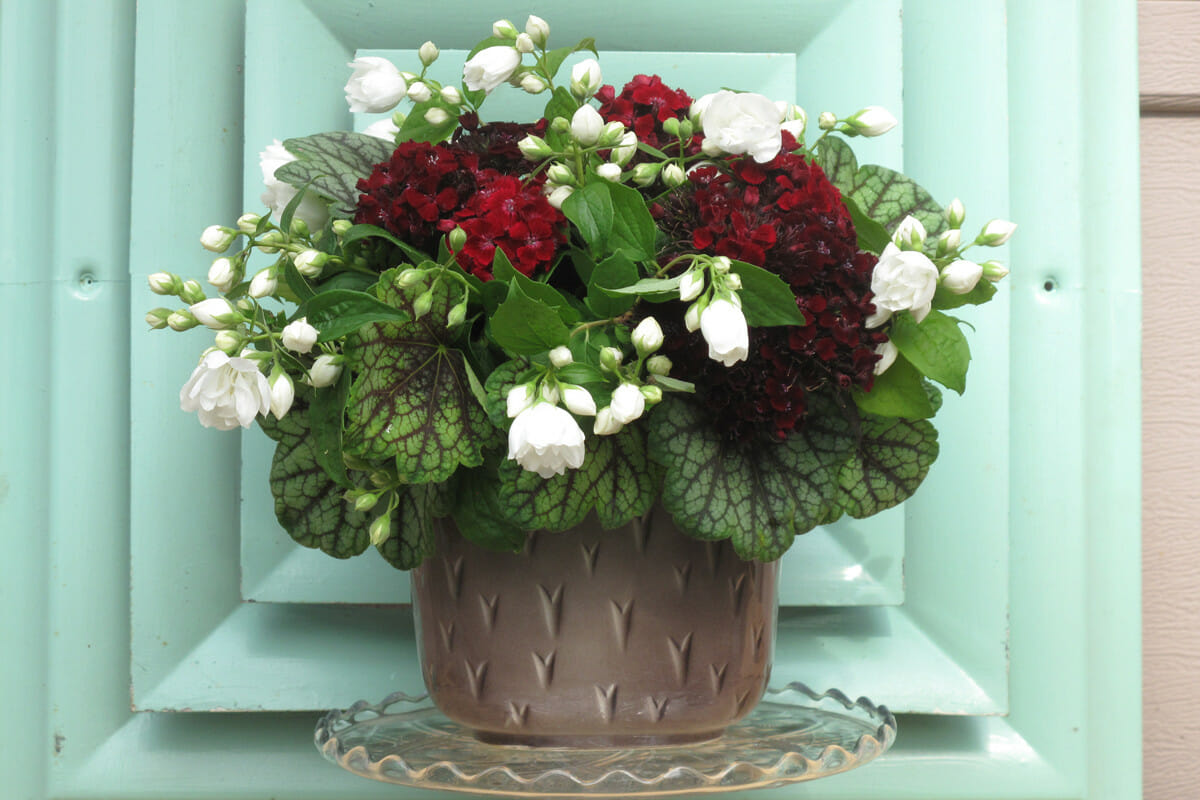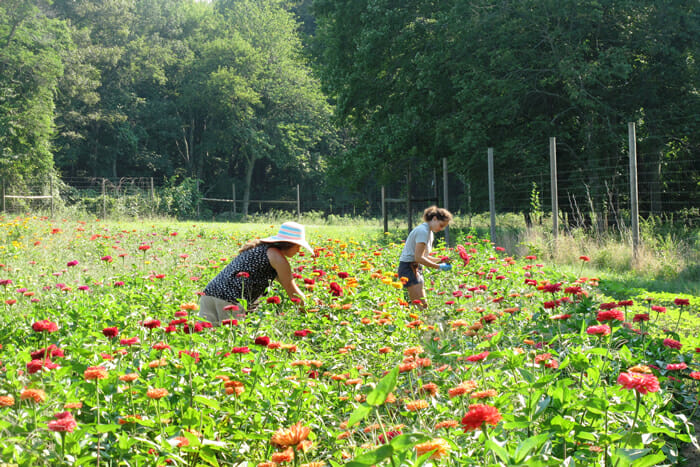Sustainable Flower Farming
The ever-growing sustainable flower market.
Sustainable Flower Farming
The ever-growing sustainable flower market.

This is not the same soulful rose that inspired countless poets and lovers.
It is, however, a Valentine’s Day blockbuster. Tomorrow, Americans will spend nearly $2 billion on cut flowers, and a dozen long-stemmed roses are the most popular choice.
According to the United States Department of Agriculture, 80 percent of all flowers sold in the U.S. are imported, primarily from South American industrial flower farms that have a history of using harsh chemical fertilizers, toxic pesticides and unfair labor practices. At the U.S. border, flowers must be fumigated to clear customs.
“They don’t know where their flowers come from or what they’ve been sprayed with. There are better options.”
If that doesn’t scream romance, consider the massive carbon footprint that results from global transportation and plastic packaging.
“People don’t realize that they have a choice,” said Lisa Zieglar, owner of The Gardeners Workshop, a small organic flower farm in Newport News, Virginia. “They don’t know where their flowers come from or what they’ve been sprayed with. There are better options.”
Zieglar is part of an emerging sustainable-flower industry, which is determined put the bloom back on much more than roses: zinnias, snapdragons, Sweet William and the like.
For $100 – not much more than a single traditional Valentine’s bouquet – Zieglar’s customers can give their sweethearts a gift card redeemable for a CSA-style share when the weather warms up. “The smart men have figured it out,” she laughed. “Their wives get flowers all summer long.”
Though the sustainable flower market is still tiny, it’s clearly growing. According to the USDA, the number of small flower farms has increased by about 20 percent during the past five years. As of the 2012 census, there were nearly 6,000 flower farms across the country.
Many small flower growers are taking a cue from organic food farmers, who have successfully harnessed the farm-to-table trend. More of us now know where our beef comes from and how our tomatoes are grown, but it rarely occurs to us to ask the same questions about the flowers on our tables.
“There’s still a lack of awareness, but the needle is moving,” says Debra Prinzing, author of Slow Flowers and The 50 Mile Bouquet (both St. Lynns Press).
—
Prinzing, who lives in Seattle, is on a crusade to educate consumers about sustainable floriculture. Her message is simple: “Most of the time, it’s possible to source sustainably grown flowers within 50 miles of where you live.” And if you can’t buy local, then at least buy domestic.
The hard part? Determining which flowers were farmed domestically. The USDA only requires labels on the boxes used to deliver flowers to the florists, rather than on individual bundles.
To help, Prinzing established www.slowflowers.com, an online directory of florists, event planners, and supermarket floral departments who use flowers grown stateside. Other helpful resources include the Association of Specialty Cut Flower Growers and Local Harvest. Some retailers, including Whole Foods and Trader Joe’s, sell flowers certified by VeriFlora, signifying growers who meet eco-friendly and fair trade standards.
Meanwhile, small flower farmers are using labels to their advantage. For example, a simple “Sustainably grown in the Northwest” sticker on cut flowers can be a very effective marketing tool.
“Many growers have become very overt about telling people that their flowers are local. They go to farmers markets and special events to explain how their flowers are raised or how they use beneficial insects,” Prinzing notes. “It puts a face on the farmer.”
Many food farmers also discover that flowers can provide a surprising, untapped stream of income. “There’s an a-ha moment when the food farmer realizes that flowers are a higher value crop,” Prinzing explains. “Flowers are an opportunity for the small farmer to diversify and sell more product to existing customers.”
To gain a competitive edge, some growers specialize in heirloom varieties that aren’t typically available at chain stores. Instead of commonplace tulips, a grower might focus on French double tulips, parrot styles, and other hard-to-find specimens.
“Flowers are finally becoming part of the dialogue about agriculture,” Prinzing said. “And people are realizing that growing food is only one way to farm.”

Follow us

This work is licensed under a Creative Commons Attribution-NoDerivatives 4.0 International License.
Want to republish a Modern Farmer story?
We are happy for Modern Farmer stories to be shared, and encourage you to republish our articles for your audience. When doing so, we ask that you follow these guidelines:
Please credit us and our writers
For the author byline, please use “Author Name, Modern Farmer.” At the top of our stories, if on the web, please include this text and link: “This story was originally published by Modern Farmer.”
Please make sure to include a link back to either our home page or the article URL.
At the bottom of the story, please include the following text:
“Modern Farmer is a nonprofit initiative dedicated to raising awareness and catalyzing action at the intersection of food, agriculture, and society. Read more at <link>Modern Farmer</link>.”
Use our widget
We’d like to be able to track our stories, so we ask that if you republish our content, you do so using our widget (located on the left hand side of the article). The HTML code has a built-in tracker that tells us the data and domain where the story was published, as well as view counts.
Check the image requirements
It’s your responsibility to confirm you're licensed to republish images in our articles. Some images, such as those from commercial providers, don't allow their images to be republished without permission or payment. Copyright terms are generally listed in the image caption and attribution. You are welcome to omit our images or substitute with your own. Charts and interactive graphics follow the same rules.
Don’t change too much. Or, ask us first.
Articles must be republished in their entirety. It’s okay to change references to time (“today” to “yesterday”) or location (“Iowa City, IA” to “here”). But please keep everything else the same.
If you feel strongly that a more material edit needs to be made, get in touch with us at [email protected]. We’re happy to discuss it with the original author, but we must have prior approval for changes before publication.
Special cases
Extracts. You may run the first few lines or paragraphs of the article and then say: “Read the full article at Modern Farmer” with a link back to the original article.
Quotes. You may quote authors provided you include a link back to the article URL.
Translations. These require writer approval. To inquire about translation of a Modern Farmer article, contact us at [email protected]
Signed consent / copyright release forms. These are not required, provided you are following these guidelines.
Print. Articles can be republished in print under these same rules, with the exception that you do not need to include the links.
Tag us
When sharing the story on social media, please tag us using the following: - Twitter (@ModFarm) - Facebook (@ModernFarmerMedia) - Instagram (@modfarm)
Use our content respectfully
Modern Farmer is a nonprofit and as such we share our content for free and in good faith in order to reach new audiences. Respectfully,
No selling ads against our stories. It’s okay to put our stories on pages with ads.
Don’t republish our material wholesale, or automatically; you need to select stories to be republished individually.
You have no rights to sell, license, syndicate, or otherwise represent yourself as the authorized owner of our material to any third parties. This means that you cannot actively publish or submit our work for syndication to third party platforms or apps like Apple News or Google News. We understand that publishers cannot fully control when certain third parties automatically summarize or crawl content from publishers’ own sites.
Keep in touch
We want to hear from you if you love Modern Farmer content, have a collaboration idea, or anything else to share. As a nonprofit outlet, we work in service of our community and are always open to comments, feedback, and ideas. Contact us at [email protected].by Su Avasthi, Modern Farmer
February 13, 2015
Modern Farmer Weekly
Solutions Hub
Innovations, ideas and inspiration. Actionable solutions for a resilient food system.
ExploreExplore other topics
Share With Us
We want to hear from Modern Farmer readers who have thoughtful commentary, actionable solutions, or helpful ideas to share.
SubmitNecessary cookies are absolutely essential for the website to function properly. This category only includes cookies that ensures basic functionalities and security features of the website. These cookies do not store any personal information.
Any cookies that may not be particularly necessary for the website to function and are used specifically to collect user personal data via analytics, ads, other embedded contents are termed as non-necessary cookies.
I am interested in starting a small scale flower farm.
Thank you.
I’d like to find out how to learn more about small sustainable flower farming
Greetings. I just retired and my husband and myself sold our house in Ottawa and bought 8 acres with a 146 yr old farm house on it. We are an hour outside of Ottawa, Ontario in a small rural community. Now I would like to nourish my passion of growing flowers and sharing the beauty with others. Feeling around for those who have already started and wanting to hear their advice or experiences in the small flower farm business.
I’m interested in farming flowers. Thanks
My daughter and I are interested in how to start a manageable flower farm. What to do and what not to do.
Southeast Kansas where do I begin?
I’m interested in small flower farm.
I am interested in starting a small flower farm in Alabama. Where can I find support
I thrive on flower gardening and would love to someday have a small flower farm. Where do we get information about this and possible apprenticeships, volunteering or internships?
Hi, I am Kah Hwee from Singapore and I am interested to learn more about small scale sustainable flower farming business, more specifically, indoor artificial environment due to the limited land space we have in Singapore. Do reach out to me if you have experience in this area. Thank you